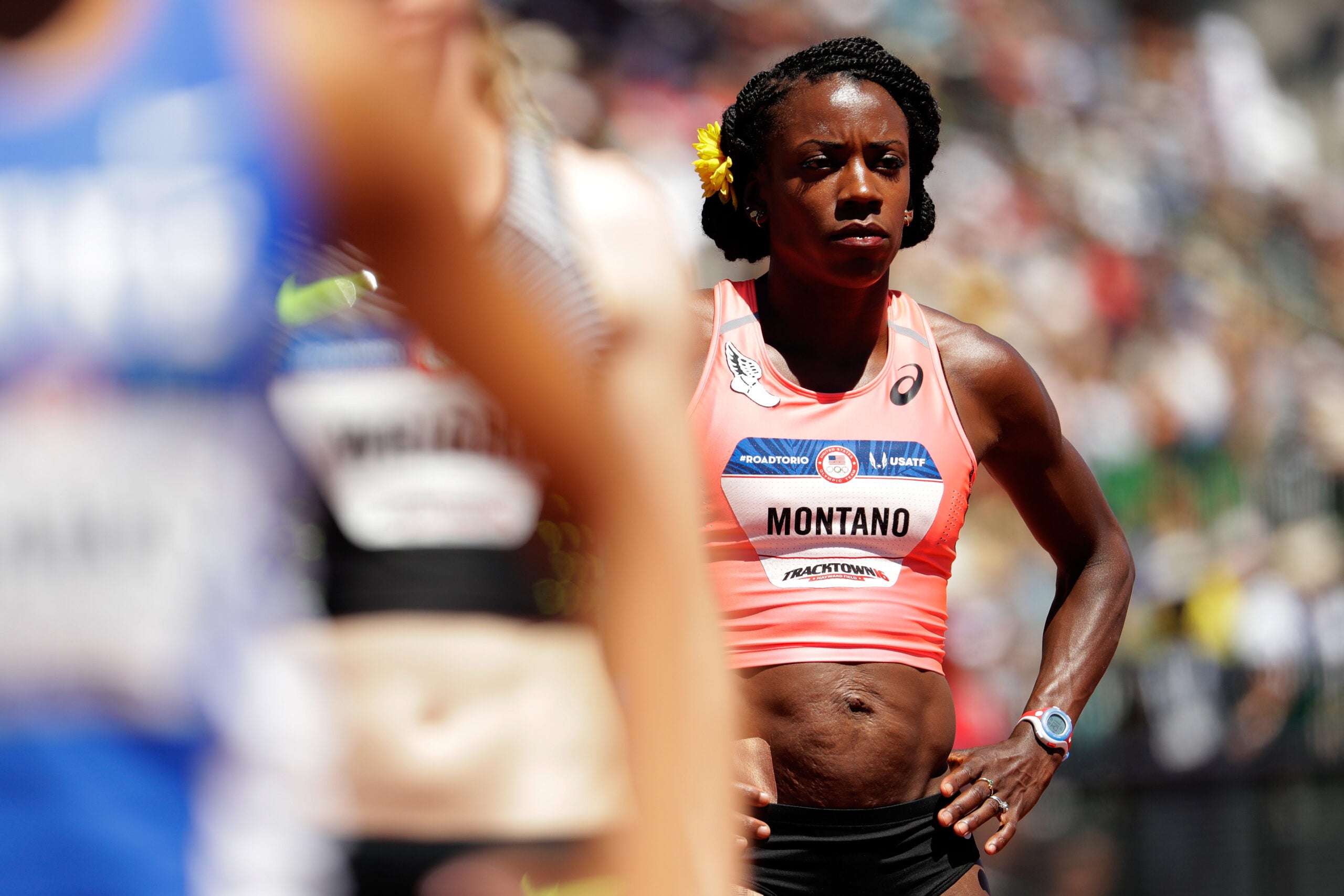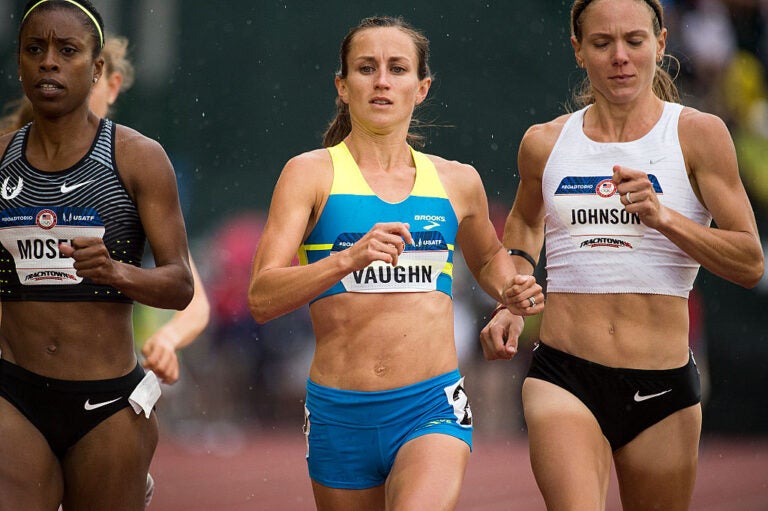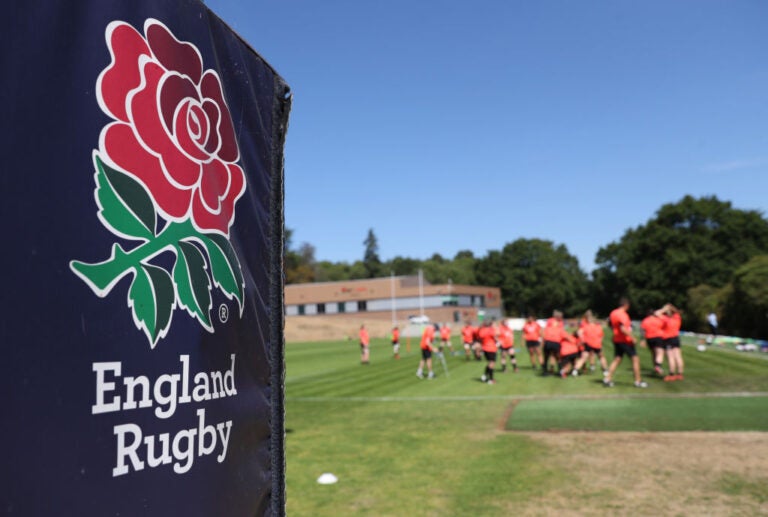Athlete Moms Are Fighting Battles in and out of Sports. What Will It Take to Win?
Why this matters
The past decade has seen unprecedented institutional gains for pregnant and parenting women athletes, yet a persistent maternal health crisis, the fight for bodily autonomy, and the continued pursuit of reproductive justice demonstrate how far there is to go.
While the United States Women’s National Soccer Team prepares to go to the FIFA World Cup this month, co-captain Alex Morgan noted how special it was to be heading to her first World Cup as a mother.
“I just want to represent athlete moms and the accomplishments and strides we have been able to make in women’s soccer,” she said.
Morgan was one of five moms in training camp, an unprecedented number. Julie Etrz and Crystal Dunn, who each had a baby in the past two years, will join Morgan as the athlete moms on the final roster.
Morgan, like many of her teammates, has been an outspoken advocate for women’s sports and is part of a cohort of modern women athletes who have pushed their respective leagues to new heights. She sees the number of moms on the national team, as well as in the National Women’s Soccer League, as a testament to gains they have made in shifting the landscape of women’s sport. For previous generations, a pregnancy would mostly signal the end of the player’s athletic career because few resources and little support existed for athletes who wanted to return to sport after a pregnancy. Now, many leagues are accounting for athletes who are pregnant and parenting and offering benefits and resources that allow athlete moms to stay on fields, courts, and tracks.
Indeed, examining policies, ideas, and discourse about athlete moms is a compelling lens through which to view the current (and historical) development of women in sport. Throughout the 20th century, ideas about women’s bodies and reproduction restricted their growth and development as athletes. And while policy around women athletes’ reproductive rights is shaped by broader societal trends, the profile and nature of sport means that athletes refract new possibilities back onto society as progress continues at the league and organizational levels.
But change is not linear: It is often a jumbled mess of gains and losses, repetition and throughlines. For all the visible celebrations of superstar moms such as Morgan or Crystal Dunn, there are still moms who have had to work side jobs to afford childcare to keep playing. There are leagues offering unprecedented support for pregnant and parenting athletes, and there is also continuing pregnancy discrimination – sometimes even in those same leagues. There are athletes fighting for reproductive rights and better maternal health outcomes, and there are athletes almost dying and dying in childbirth. Teasing out this messy measurement of progress reveals the possibilities and constraints facing the modern sportswoman. The increased support for athlete moms shows that we are in the midst of a new dawn in women’s sports while the lingering challenges illuminate the barriers still standing in the way of progress.
A Look Back
Pierre de Coubertin, founder of the modern Olympic Games, was unflinchingly clear in his opposition to women’s participation in athletics. “An Olympiad with females would be impractical, uninteresting, unaesthetic, and improper,” Coubertin once said. “It is indecent that spectators should be exposed to the risk of seeing the body of a women being smashed before their eyes. Besides, no matter how toughened a sportswoman may be, her organism is not cut out to sustain certain shocks.”
Coubertin’s lament about the fragility of a modern sportswoman’s “organism,” promoted and reflected prevailing pseudoscience in the early 20th century that deemed women too fragile for competitive sport. The primary concern centered on women’s reproductive health and abilities and was used as justification to restrict, control, and hinder the development of organized athletics for girls and women.
As women’s sports grew in popularity over the course of the 20th century, the scrutiny over athlete’s reproductive health persisted and was prevalent around the world. In 1925, Dr. Elliot Rawlings took to the pages of the Black press to warn of the “modern girls” who “forget their sphere in life.” Rawlings claimed that things like “basketball,” “broad jumping,” and other forms of “over-active physical exertion” were damaging the reproductive organs of these so-called “new women.” He lamented the fact that when these sporting girls finally get “settled down and married,” their reproductive organs “cannot endure or perform those obligations and functions that nature demands of women.”
In the 1940s, Brazilian doctor Leite de Castro used a similar rationale to argue against women playing soccer. As historians Brenda Elsey and Josh Nadal note in their book Futbolera, Castro claimed that “sports diverted women from their biological destiny.” The ideas were clear: Women’s function in society was to reproduce, and sports threatened that.
As women’s sports continued to grow mid-century, the “scientific” concern over reproduction morphed into a social concern about desirability. Articles in newspapers and magazines cautioned against women developing too many muscles, lest they become too “manly” to find a husband or – worse – become lesbians. One Olympic coach in the 1960s cautioned that modern sports were “detrimental to the development of women as women,” adding that “they cannot hope to keep up without surrendering their sex.”
Related: What Happens When an Athlete Takes ‘The Pill’?
These ideas about women’s bodies impacted the organization of sport. Sports that were seen as less strenuous and gender-affirming, such as tennis, golf, swimming, and gymnastics, often were more accessible and available. They were also understood to be upper-class, White sports. Other sports were more heavily scrutinized. With organizers relying on enduring faulty logic about women’s bodies, marathons and distance events in the Olympics were restricted to men. It wasn’t until the 1960s when women were able to run 800 meters in Olympic competition. Indeed, the 1970s saw numerous battles to allow women to be included in marathons and for the women’s marathon to be included in the 1980 Olympic Games. Despite successes of women marathoners over the course of the decade, Olympic officials still questioned the inclusion of the race leading up to the 1980 Olympics, citing the same concerns over women’s health that had been circulating for the previous century.
Title IX shifted the landscape of U.S. women’s sports in the later years of the 20th century and ushered in a new era of women athletes who demanded access to sport, challenging prevailing logics around bodily capabilities and gender roles in society. Athletics were a proving ground where women could showcase strength, demand equal opportunity, display mental toughness, and challenge institutional barriers. These modern sportswomen of the 1980s enjoyed a new level of professional opportunity and visibility as organized athletics grew and expanded.
Some athletes began talking openly about their pregnancies, insisting that giving birth did not mean the ends of their careers. Track star Evelyn Ashford carried her daughter around the track after meets and said motherhood made her a stronger runner. Her Olympic teammate, Valerie Brisco, echoed similar sentiments – and her three gold medals at the 1984 Summer Olympics after she had her son seemed to confirm this. German luger Steffi Walter won gold at the 1988 Winter Games – one year after giving birth.
The coverage of pregnant and parenting athletes framed their successes as a refutation of the idea that sports threatened reproductive abilities and that women in sport were all masculine lesbians. Athlete moms stood as symbols of the modern hetronormative, feminine, and marketable sportswoman. As one Sports Illustrated article noted, having a baby allowed “women to reach their athletic potential by reassuring them of their femininity.”
While this increased coverage demonstrated how women’s sports had grown, the logistical and financial burdens most of them faced were reminders that the infrastructure of women’s sports was undervalued, underfunded, and wobbly. Those same sports that were most welcoming to women in early decades now presented them with the most earning potential – a fact that remains true today. For some moms on the tennis or golf circuits, what they lacked in institutional support they could supplement with their earnings. Golfer Nancy Lopez earned millions of endorsement dollars on the Ladies Professional Golf Association tour, where she dominated the sport while carting her daughters around.
In juxtaposition, soccer player Joan Dunlap, was able to get childcare with her scholarship to play soccer at the University of North Carolina in the 1980s, but since there was not yet a functional professional women’s soccer league (or even a national team), Dunlap had little hope for a professional career as a mother or otherwise. Dunlap would actually go on to become the first mom in U.S. women’s national team history when she played for the inaugural national team in 1986. However, the lack of pay and infrastructure, plus sporadic travel that players had to pay for, cut Dunlap’s career short. “There wasn’t a place carved out for her yet,” soccer legend Michelle Akers said when reflecting on the barriers that generation faced.
The growth of women’s professional leagues in the 1990s increased the spotlight on women’s sports. The endorsement deals and marketing that star Olympians like gymnastics’ Mary Lou Retton and track’s Florence Griffith “Flo Jo” Joyner were able to earn started to be accessible to athletes in team sports as well, like soccer superstar Mia Hamm battling basketball superstar Micheal Jordan for Gatorade. Just before the 1996 Olympics, Nike released the Air Swoopes, a ground-breaking signature shoe with basketball’s Sheryl Swoopes.
After the Olympics, Swoopes was primed to be the face of the newly founded Women’s National Basketball Association. With marketing plans set and excitement building, Swoopes announced she was pregnant. Her agents and the league decide to lean into it, deciding that athlete moms were marketable. Using familiar language, one ad executive gleefully proclaimed that Swoopes was “a symbol to working mothers everywhere.” Her pregnancy was positioned as proof that modern women athletes could have it all – a baby and a professional career. The league also thought Swoopes would be a good symbol to its targeted audience: families. When Swoopes appeared on the inaugural cover of Sports Illustrated Women, she was pictured pregnant and holding a basketball next to a headline that announced “A Star is Born: Both Swoopes and the WNBA are due in June.”
Although Swoopes symbolized a new era for the modern sports women, there was a gap between marketing and infrastructure. Women athletes were earning money through endorsement dollars, not base pay. Other moms who were not as famous or as marketable as Swoopes continued to struggle with making a livable wage, let alone one to support a family on.
And while basketball, soccer, tennis, golf, and track continued to reach new heights, women in other sports were facing continued barriers held up by the same historical concerns over women’s bodies and reproduction. Concern over menstruation and muscles hindered the development of women’s weightlifting, for instance. And as recently as 2009, when debates were occurring around adding women’s boxing to the Olympics, the main arguments against inclusion were psychological concerns, reproduction dangers, and even an idea that being punched in the breast might lead to women boxers developing breast cancer.
Tracing this history of ideas around women’s sports and reproduction illuminates the durability of ideas we see echoed today. And as leagues continue to grow and marketing dollars flow, the past generations of athlete moms are similarly instructive. For every gain celebrated, it is clear that battles of the past are still being fought today.
A Look Forward
We are now in a new generation of women’s sports. This era has been marked by vocal athletes who have pushed and dragged their respective leagues to new heights – from superstar athletes using their platforms to demand change to strong labor unions that bring the combined force of hundreds of athletes. Fights for equal pay, social activism, and new media deals have brought women’s sports to new heights. The modern sportswoman stands at the intersection of pressing societal issues, using their positions as athletes – and for some athletes, as moms – to press for change within and outside of sport.
Tennis legend Serena Williams’ pregnancy was international news. The realization that she had won the Australian Open while pregnant was heralded by many as continued proof about how amazing women’s bodies are. However, it was her return to the tennis circuit after giving birth that really made waves. When Serena returned to competition, she was unranked, as pregnancy was treated like a player returning from injury. This sparked a debate about how maternity leave should be considered by the Women’s Tennis Association and led to a 2019 rule change that introduced a special ranking system to not penalize women who were returning from childbirth.
As with Swoopes, Nike saw a pregnant and parenting Serena Williams as incredibly marketable. In an ad campaign titled “Dream Crazier,” Nike celebrated her return to tennis after giving birth. Yet Nike’s public support for Williams unintentionally illuminated a gap in the support they gave to other sponsored athletes.
In the wake of the ad campaign, pro runner Alysia Montano came forward with a story of how Nike had frozen her pay upon learning she was pregnant, writing, “Nike told me to Dream Crazier, until I wanted a baby.” Soon, she was joined by other Nike-sponsored pro runners, Allyson Felix and Kara Goucher, who shared similar stories. Their outspokenness led to Nike changing its policy on pregnant athletes and added to the growing conversations about institutional support for women’s sports.
The athletes of the Women’s National Basketball Association addressed some of these institutional concerns in their groundbreaking collective bargaining agreement with the league in 2020. While salary gains garnered a lot of attention, some observers like journalist Maggie Mertens aptly argued that maternity leave and paternal benefit policies were the real victory of the CBA. While the previous agreement had provided partial pay for players during maternity leave, the new agreement provided maternity leave with full salary, dedicated nursing areas, and childcare stipends. Additionally, veteran players could receive reimbursement up to $60,000 for fees related to adoption, surrogacy, egg freezing, and fertility treatment.
These additional benefits critically expand the infrastructure around familymaking – especially for queer parents. Athlete moms have largely been celebrated and marketed as testaments to heteronormative femininity, but these new policies expand the lens on what athletic motherhood looks like. The NWSL signed its first-ever CBA in 2022, and the agreement included paid leave for birth or adoption.
Related: Women Athletes Are Disrupting Traditional Perspectives on Parenthood
The gains are clear, but the risk of measuring progress from the top is that you obscure the existing and persisting gaps. While the USWNT celebrated the moms at training camp, French national team players were discouraged from bringing their kids around at all. Sara Bjork Gunnarsdottir, an Icelandic soccer player, had to fight her former club, Lyon, for her paycheck during her pregnancy. The storied club threatened her future with the team if she pursued her claim with FIFPRO, the global football players union. “This is about my rights as a worker, as a woman, and as a human being,” Bjork wrote in The Players’ Tribune, adding “I’m very hopeful about the women’s game. There’s a lot to celebrate. The facilities? The investment? The level? The fans filling up the stadium? We’ve come so far. That’s undeniable … but there’s a lot more work to do.”
Tennis player Tatjana Maria echoed similar sentiments when she pointed out that while the WTA has made progress in ranking players returning from pregnancy and providing childcare facilities at the four Grand Slam tournaments, it continues to be lacking at the small tournaments on the circuit. Even the WNBA’s benefits package upon second glance seems like a smaller step when you consider that an athlete must play eight years in the league before qualifying for the family planning reimbursements.
Starting forward Dearica Hamby found out she was pregnant with her second child as she helped the Las Vegas Aces win their first WNBA title. She understood that the WNBA CBA now covered her full maternity leave, and she planned to be back by the start of the following season. Hamby was not expecting to be suddenly traded in a move she publicly called out as pregnancy discrimination. “To be treated this way by an organization, BY WOMEN who are mothers, who have claimed to ‘be in these shoes,’ who preach family, chemistry, and women’s empowerment is disappointing and leaves me sick to my stomach,” Hamby wrote on Instagram. “We fought for provisions that would finally support and protect player parents. That cannot now be used against me.” A league investigation found that Aces coach Becky Hammon had indeed violated Hamby’s rights by not maintaining a respectful working environment when she questioned her commitment to the team because of her pregnancy.
The fight for paid maternity leave and expansive family policies and against pregnancy discrimination are not issues limited to athletics, and it is clear that the athletes see their labor battles as wins for working women and women in society writ large. Los Angeles Sparks forward Chiney Ogumike called the WNBA’s CBA “ground establishing,” adding “for women to have an opportunity to get paid on maternity leave, why is that something novel?”
Pregnancy discrimination and pay equality are social issues that have been magnified in sports over the past few years. Less discussed but similarly pressing are bodily autonomy and abortion rights. The choice to not be pregnant has been historically muted in conversations about athletes and motherhood. However, the rising threats to legal abortion have made women athletes more vocal about their own experiences, sharing their own abortion stories and speaking publicly about how access to safe and legal abortions has impacted their careers.
Last year, more than 500 women athletes, including athletes from the WNBA and NWSL, submitted an amicus brief to the Supreme Court while the justices were hearing the Dobbs case challenging Roe v. Wade. The testimonies included in the brief argued that, for professional athletes, the right to abortion was essential to the growth and development of women’s sports. “As an elite athlete, I know I have a finite length of time to pursue my dreams in my sport,” one Olympian explained. “I have honed my body and my mind through my efforts. To have any of that autonomy taken away, to have someone else make decisions for my body and my career, is to take away my life’s pursuit.”
Black women athletes are also using personal testimony to share their birth stories and struggles in an effort to raise awareness about the persistent Black maternal mortality rate in the U.S. Black women in this country are twice as likely to experience severe pregnancy complications and three times as likely to die in childbirth. These horrifying statistics remain true even when statistics are controlled for wealth and education level. Athletes such as Serena Williams, Allyson Felix and Tiana Madison have detailed their near-death childbirth experiences in which their lives and that of their children was at risk.
This year, Olympian Tori Bowie was found dead in her home at 32. She was eight months pregnant and in labor at the time. In 2016, Tori, full of life, ran the anchor leg on the gold medal-winning relay team at the Rio Olympics. Two of her teammates on that relay were Felix and Madison. “THREE (3) of the FOUR (4) of us who ran on the SECOND fastest 4x100m relay of all time, the 2016 Olympic Champions have nearly died or died in childbirth,” Madison wrote on Instagram. Added Felix: “We’re dealing with a Black Maternal Health crisis. Here you have three Olympic champions, and we’re still at risk.” Both women are mourning their teammate’s death and once again raising awareness about the black maternal mortality rate. “I’m hopeful that things can get better,” wrote Felix, “ I’m hopeful that Tori, who stood on the podium at Rio, gold around her neck and sweetness in her soul, won’t die in vain.”
Bowie’s haunting death is the worst-case reminder that we cannot separate the modern sportswoman from broader society. What does it mean to consider the gains in women’s sports alongside the persistent Black maternal mortality rate? Perhaps they seem disconnected, but for Black women athletes who are or will become pregnant, they are inextricable from the other. What good are progressive policies if you’re not alive to use them? How do we celebrate the 50th anniversary of Title IX when it coincides with the rollback of federal abortion protection under Roe v. Wade?
Considering ideas about athlete motherhood past and present reveals both the gains of women in sport as well as the persistence of certain barriers, assumptions, and concerns still restricting the development of the game. This generation of women athletes understands that they sit at a particular intersection of sport and society. They see that their fights for pay equity, paid maternity leave, bodily autonomy, queer family protections, maternal health and wellness, and mental health and safety are fights that are mirrored in and out of sports. And while we celebrate athlete moms like Alex Morgan and Crystal Dunn taking the field this month at the World Cup as markers of progress, their presence should not be seen as a final victory in this fight but rather as a reflection of the excellence that is possible when workers are respected, protected, and invested in, mothers or otherwise.
Monthly Issue
The Modern Sportswoman
After a record-breaking March Madness in the United States and heading into what is sure to be a strong FIFA World Cup this summer, women throughout the world are using this growth to secure greater security and influence.
Explosive growth is exciting, but intentional growth could create the power, permanence, and protection that women’s sports deserves.
We explore what that growth could look like in our latest digital issue.





